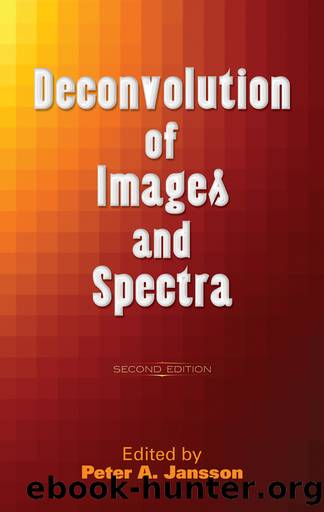Deconvolution of Images and Spectra: Second Edition (Dover Books on Engineering) by Engineering

Author:Engineering [Engineering]
Language: eng
Format: epub
Publisher: Dover Publications
Published: 2014-05-04T16:00:00+00:00
Figure 9 Deconvolving s(x) = sinc(x) and s(x) = sinc2 (x) convolved data. Trace a is the original spectrum o(x) , trace b the result of convolving with an eight-point sine function, and trace c the result of unconstrained deconvoltuion using the same sine function for just 10 iterations. Trace d is the result of 100 iterations using “zero clipping.” Trace e is the original spectrum convolved with an 8√2-point sinc-squared function, trace f the result of deconvolving trace e with the same sinc-squared function for 100 iterations using the Jansson-type relaxation function r(k) [o(k-1) (x)].
The negative sidelobes of the unapodized spectrum render the constraints defined earlier useless. Trace c of Fig. 9 shows the result of unconstrained deconvolution. After only five iterations the algorithm begins to diverge and, as seen in Fig. 9 , the spectrum is worse for our trouble. Trace d shows the result of zero clipping. Although there is some improvement and convergence does occur, the resulting spectrum appears real but is not a faithful representation of the original spectrum shown in trace a, particularly where several lines overlap in the convolved spectrum. Trace e represents the same spectrum with triangular apodization used to generate a response function s(x) = (sin 2 πx)/π 2 x 2 = sinc 2 (x). Although some resolution is lost, the negative lobes are eliminated and the positive sidelobes greatly reduced. Such a spectrum can be deconvolved with the Jansson weighting technique even in the presence of the sidelobes (which are now all nonnegative). The result is shown in trace f. This spectrum shows resolution equal to or slightly better than the unapodized spectrum shown in trace b and the sidelobes have been almost completely eliminated. For a very crowded spectrum this would appear to be a useful technique, particularly if there is interest in the weaker lines of the spectrum.
B. PRESSURE-BROADENED INFRARED AND RAMAN SPECTRA
In all the previous simulations we have assumed a narrow Gaussian line profile that results from Doppler broadening. This is often not the case, owing to the presence of pressure broadening that results in a Lorentzian line profile at sufficiently high pressures. This often means an unavoidable loss of resolution. To observe a spectrum when the transition intensities are low, it is often necessary to increase the sample gas pressure. In this case the pressure broadening can be sufficient to mask important spectral features. Conversely, when the pressure is low enough to allow these important spectral features to be resolved, they may be too weak to observe at achievable signal-to-noise ratios. To some extent this problem can be alleviated by using deconvolution to remove pressure-broadening effects (as well as instrumental effects). This is demonstrated for two cases: a simulated absorption spectrum and a simulated Raman spectrum.
For an absorption spectrum the effects of pressure broadening can be approximated by convolving the spectrum with a Lorentzian of the proper width. (An accurate representation would require us to carry out the convolution on the absorption coefficient spectrum.) Thus a
Download
This site does not store any files on its server. We only index and link to content provided by other sites. Please contact the content providers to delete copyright contents if any and email us, we'll remove relevant links or contents immediately.
Whiskies Galore by Ian Buxton(40334)
Introduction to Aircraft Design (Cambridge Aerospace Series) by John P. Fielding(32338)
Small Unmanned Fixed-wing Aircraft Design by Andrew J. Keane Andras Sobester James P. Scanlan & András Sóbester & James P. Scanlan(32141)
Craft Beer for the Homebrewer by Michael Agnew(17447)
Turbulence by E. J. Noyes(7041)
The Complete Stick Figure Physics Tutorials by Allen Sarah(6640)
Kaplan MCAT General Chemistry Review by Kaplan(6054)
The Thirst by Nesbo Jo(5786)
Bad Blood by John Carreyrou(5770)
Learning SQL by Alan Beaulieu(5412)
Weapons of Math Destruction by Cathy O'Neil(5038)
Man-made Catastrophes and Risk Information Concealment by Dmitry Chernov & Didier Sornette(4738)
iGen by Jean M. Twenge(4702)
Digital Minimalism by Cal Newport;(4545)
Life 3.0: Being Human in the Age of Artificial Intelligence by Tegmark Max(4509)
Audition by Ryu Murakami(4099)
1,001 ASVAB Practice Questions For Dummies by Powers Rod(4040)
Electronic Devices & Circuits by Jacob Millman & Christos C. Halkias(4029)
Pale Blue Dot by Carl Sagan(4003)
